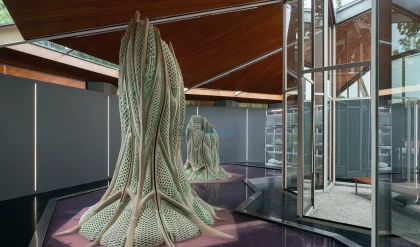
A remarkable new discovery at the Gray Fossil Site near East Tennessee State University (ETSU) has unveiled the existence of a giant, strong-jawed salamander that once roamed the ancient forests of Tennessee. This exciting finding contributes to ongoing research on the evolution and diversity of Appalachian amphibians, particularly within the unique ecosystem of Southern Appalachian forests.
Recent research published in the journal Historical Biology highlights the work of a dedicated team from the Gray Fossil Site and ETSU, including Davis Gunnin, Assistant Collections Manager, Dr. Blaine Schubert, Director and Professor of Geosciences, Dr. Joshua Samuels, Head Curator and Associate Professor of Geosciences, Museum Specialist Keila Bredehoeft, and Assistant Collections Manager Shay Maden. Their collaborative effort demonstrates the dynamic research environment at ETSU, as noted by Dr. Joe Bidwell, dean of the College of Arts and Sciences, who emphasized the university’s crucial role in preserving and exploring the region’s natural history.
The discovery of the newly identified species, Dynamognathus robertsoni, offers insight into the evolutionary past of salamanders in the region. Once measuring approximately 16 inches in length, this prehistoric salamander stands among the largest ever documented in the area. The implications of this find are significant, as current Appalachian ecosystems boast an impressive diversity of over 50 different salamander species, particularly lungless salamanders belonging to the family Plethodontidae. This family is notable for its unique adaptations and is representative of a larger evolutionary narrative that stretches back millions of years.
Researchers believe that salamanders like the dusky variety, prevalent in the streams of the Appalachian Mountains, evolved from burrowing ancestors, akin to Alabama’s Red Hills salamander. The diversification of these species began around 12 million years ago, significantly influencing the development of modern salamander communities. The discovery of Dynamognathus robertsoni challenges previous assumptions regarding the geographical distribution and ecological relevance of burrowing salamanders in ancient North America.
Gunnin remarked on the unexpected nature of finding such a species in East Tennessee, noting its current limited range in southern Alabama. This discovery indicates that large, burrowing salamanders were once more broadly distributed across the eastern United States and likely played a pivotal role in shaping the evolution of the Appalachian salamander populations.
In discussing the characteristics of this fascinating new species, the researchers highlighted its formidable bite force, attributed to its unique cranial anatomy. The genus name, Dynamognathus, translates from Greek as “powerful jaw,” illustrating the salamander’s robust nature in comparison to its living relatives. The species name robertsoni honors Wayne Robertson, a dedicated volunteer who first identified the specimen and has contributed significantly to the excavation efforts at the site since 2000.
As researchers continue to excavate and analyze fossils at the Gray Fossil Site, they uncover invaluable insights into the region’s rich natural history. The collaboration between volunteers, students, and faculty exemplifies the commitment to scientific exploration at ETSU, reinforcing its status as the flagship institution of Appalachia. The discovery of Dynamognathus robertsoni not only enhances our understanding of salamander diversity but also showcases the vibrant academic community dedicated to uncovering the mysteries of the past.
Reference:
- Davis Gunnin, Blaine W. Schubert, Joshua X. Samuels, Keila E. Bredehoeft, Shay Maden. A new plethodontid salamander from the Early Pliocene of northeastern Tennessee, U.S.A., and its bearing on desmognathan evolution. Historical Biology, 2025; 1 DOI: 10.1080/08912963.2025.2501332






